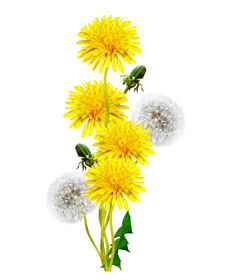In Praise of Weeds
November 1, 2019Podcast: Download (Duration: 5:21 — 7.3MB)
Subscribe: More
Pity the poor dandelion. It is, in many ways, nature’s perfect plant. Its tender, young greens make a tasty addition to any salad. The dandelion’s leaves contain more beta-carotene than carrots and more iron than spinach. Its blossoms, when properly fermented, perhaps with a bit of orange or lemon, make a sweet white wine. That tap root contains medicinal properties, and can be beneficial to both the liver and the kidneys as both a diuretic and blood cleanser. It can also be dried, roasted and ground as a coffee substitute. The flower’s white, milky sap can be used to alleviate bee stings and to remove calluses and moles. Nature’s perfect plant.
Yet, plunk a dandelion down in the middle of a manicured suburban lawn and it is treated like a terrorist. Armies of lawn care professionals are dispatched with chemical and biological weapons of mass destruction to eradicate this menace. It is, after all, a weed. Americans spend more than a billion dollars a year on more than 100 million pounds of herbicides, pesticides and other
lawn-care chemicals in their attempts to rid their yards of these and other pesky plants.
What, then, makes a weed? Is a weed a weed just because we call it that? Ralph Waldo Emerson once said that a weed is simply a plant whose virtues we haven’t yet discovered. But I don’t think that’s quite right. Long ago we discovered the virtues of the dandelion, yet they are a public menace. In his book Second Nature, author and gardener Michael Pollan describes the strict hierarchy of plants, where the top spaces are occupied by what he calls the “hypercivilized hybrids” like roses, and the bottom tier is infested with the weeds, which he calls “the plant world’s proletariat, furiously reproducing and threatening to usurp the position of their more refined horticultural betters.” Weediness, he tells us, is determined by several factors, including how highly hybridized a plant is (the more refined and cultured, the better), the ease or difficulty of growing it (the hearty and easily adaptable larkspur is more “weedy” than, say, a fragile, delicate orchid), and, finally, its color. (White, of course, is at the top.)
 Pollan goes on to tell us that there are two primary schools of thought when it comes to weeds. The first holds that “a weed is any plant in the wrong place” and the other defines a weed to be “any aggressive plant that competes successfully against cultivated plants.” “The metaphysical problem of weeds,” he writes, “is not unlike the metaphysical problem of evil: Is it an abiding property of the universe, or an invention of humanity?”
Pollan goes on to tell us that there are two primary schools of thought when it comes to weeds. The first holds that “a weed is any plant in the wrong place” and the other defines a weed to be “any aggressive plant that competes successfully against cultivated plants.” “The metaphysical problem of weeds,” he writes, “is not unlike the metaphysical problem of evil: Is it an abiding property of the universe, or an invention of humanity?”
As I’ve considered and encountered weeds, I have become increasingly troubled and uneasy. For as the crops of our country’s farmlands have ripened and, in some cases, shriveled on the vine, I hear the language of weeds being used in our nation’s debate about the “problem” of illegal immigration. We, the precious flowers of our highly hybridized civilization, are under siege from these uncultured invaders. “Aliens” we call them, “Illegals.” Labels that, like the term “weed” imply that they are a scourge, a menace, to be eradicated.
When we label these people—these mothers and fathers and grandparents and children—as “illegal aliens” we dehumanize them. And once they are dehumanized it is easy to talk about them as things, as problems, as so much kudzu to be beaten back at the border, lest our garden be overtaken and all that we have cultivated destroyed. What has been lost in the debate over our immigration situation is the fact that each of the individuals who live in our country without documentation is a human being, a person with a family and a story just like us. They may not be highly hybridized flowers in the top tiers of the garden’s hierarchy (though some of them could be, I’m sure, given the chance). But nor are they weeds to be uprooted and eradicated from the rich soil of this nation.
In describing the process by which we cultivate our gardens, Michael Pollan tells us that “weeding is the process by which we make informed choices in nature, discriminate between the good and bad, apply our intelligence and sweat to the earth.” We owe at least this same level of care, discrimination and intelligence to the human beings who sit at the heart of the immigration debate.
- Answering the Angels - December 1, 2019
- In Praise of Weeds - November 1, 2019
- Freedom From. Freedom To - May 1, 2018
Quest Monthly Print Edition
Recent Issues
Latest Spiritual Reflection Posts
Weekly Newsletter
About
Quest for Meaning is a program of the Church of the Larger Fellowship (CLF).
As a Unitarian Universalist congregation with no geographical boundary, the CLF creates global spiritual community, rooted in profound love, which cultivates wonder, imagination, and the courage to act.
Contact
Church of the Larger Fellowship Unitarian Universalist (CLFUU)
24 Farnsworth Street
Boston MA 02210

